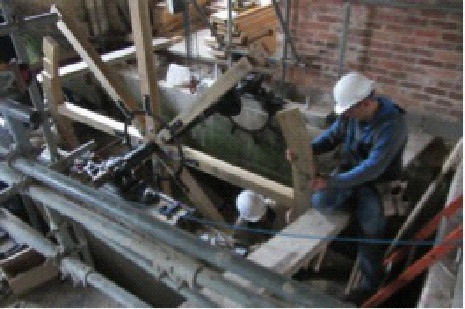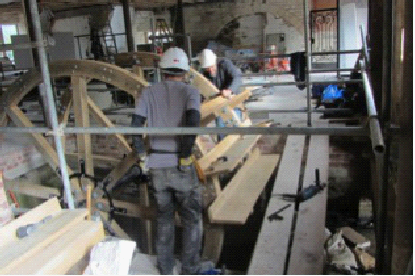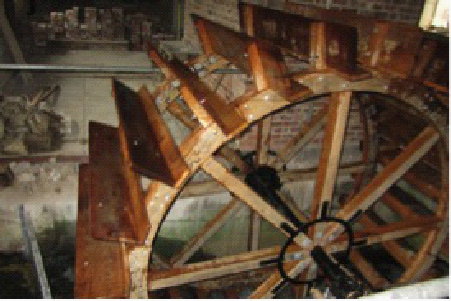

We’ve talked about this mill in the past but to recap briefly, it was built around 1815 to produce woollen cloth and was later converted successively to a maltings, corn mill, saw mill, and finally used for the storage of antiques. The past few years have seen an extensive programme of rebuilding of the main mill and its conversion into apartments.
The ground floor has become a large open entrance area. As part of this, two of the remaining wheel pits that formerly housed the three large 15 ft diameter water wheels that originally provided power for the mill, were opened up. It’s now possible to see the river flowing under the mill through their outlet tunnels. This now makes an interesting feature and focal point for the lobby area. To further enhance this, one of the pits has now been fitted with a new water wheel. This has been made largely of wood and was designed and constructed by David Empringham Woodworking of High Wycombe. The company has worked on a number of important heritage projects around the country that have included both traditional water mills and windmills. Recent projects have included a windmill in Oxfordshire and a watermill in Worcestershire. Closer to home, between 2002 and 2009, they also restored Stanway watermill near Winchcombe. This now produces flour using locally grown grain. Their work gained an award from the CPRE (Campaign for the Protection of Rural England), citing the comprehensive, meticulous restoration.
At Millend Mill, the company manufactured a complete set of parts that included a pattern for the hubs, a machined steel shaft with shell bearings, and oak rims and spokes, paddles, etc. for the wheel. The individual components were made off site, with the wheel being assembled piece-

The wheel’s shaft in place
and the first side frame being assembled

The assembly process went like clockwork, and the entire wheel was put together over the course of less than a week. At the moment, it’s purely ornamental. However, it’s hoped that at some point in the future, it can be coupled up to power an electrical generator. This will produce pollution-
Nearing completion,
with the first paddles being fitted

The company redeveloping the mill should be commended for the current project.
There has been no requirement for them to fund and install a water wheel – it has simply been a desire to create something special in what is already an elegant building with a long interesting history. Similarly, they have been careful to retain various other features that reflect the mill’s lengthy working life. Its conversion and re-
The finished article -
Stephen Mills
Millend Mill -
Published in ECN 149 Feb/Mar 2015
Over the course of a week during last October, something quite remarkable happened in Eastington. For the first time in nearly a century, a water wheel driven by the River Frome began turning in one of our two remaining mills
Millend Mill restoration

